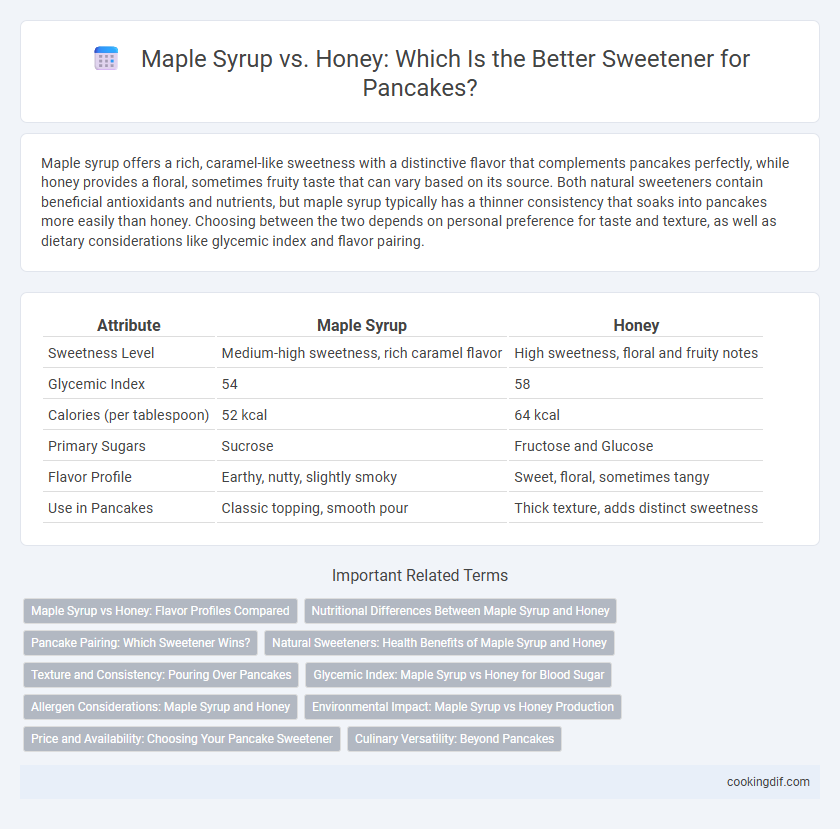Maple syrup offers a rich, caramel-like sweetness with a distinctive flavor that complements pancakes perfectly, while honey provides a floral, sometimes fruity taste that can vary based on its source. Both natural sweeteners contain beneficial antioxidants and nutrients, but maple syrup typically has a thinner consistency that soaks into pancakes more easily than honey. Choosing between the two depends on personal preference for taste and texture, as well as dietary considerations like glycemic index and flavor pairing.
Table of Comparison
| Attribute | Maple Syrup | Honey |
|---|---|---|
| Sweetness Level | Medium-high sweetness, rich caramel flavor | High sweetness, floral and fruity notes |
| Glycemic Index | 54 | 58 |
| Calories (per tablespoon) | 52 kcal | 64 kcal |
| Primary Sugars | Sucrose | Fructose and Glucose |
| Flavor Profile | Earthy, nutty, slightly smoky | Sweet, floral, sometimes tangy |
| Use in Pancakes | Classic topping, smooth pour | Thick texture, adds distinct sweetness |
Maple Syrup vs Honey: Flavor Profiles Compared
Maple syrup delivers a rich, caramel-like sweetness with subtle smoky undertones, enhancing pancakes with a complex depth of flavor. Honey offers a floral, fruity sweetness that varies based on its botanical source, providing a lighter and more fragrant taste. Choosing between maple syrup and honey depends on whether you prefer a robust, earthy sweetness or a delicate, aromatic finish on your pancakes.
Nutritional Differences Between Maple Syrup and Honey
Maple syrup contains 52 calories and 12.7 grams of sugar per tablespoon, offering a richer source of manganese and zinc compared to honey. Honey has about 64 calories and 17 grams of sugar per tablespoon, with higher amounts of antioxidants and vitamins like vitamin C and B6. Both sweeteners provide natural sugars and unique antioxidants, but maple syrup boasts lower sugar content and essential minerals, while honey offers greater vitamin diversity.
Pancake Pairing: Which Sweetener Wins?
Maple syrup offers a rich, caramelized flavor with a smooth consistency that complements the fluffy texture of pancakes, enhancing their warmth and depth. Honey provides a floral sweetness and thicker texture, adding a natural complexity that balances the buttery richness of pancakes. For pancake pairing, maple syrup often wins due to its classic, well-rounded taste that perfectly melds with the comfort of pancakes.
Natural Sweeteners: Health Benefits of Maple Syrup and Honey
Maple syrup and honey are both natural sweeteners rich in antioxidants and essential minerals like manganese and zinc, contributing to health benefits beyond basic sweetness. Maple syrup contains lower glycemic index sugars, which may lead to more stable blood sugar levels compared to honey's higher fructose content. Choosing between these natural sweeteners depends on individual dietary needs, with maple syrup favoring mineral intake and honey offering antimicrobial properties.
Texture and Consistency: Pouring Over Pancakes
Maple syrup boasts a smooth, fluid texture that evenly coats pancakes, enhancing every bite with a consistent sweetness. Honey features a thicker, stickier consistency, creating a more concentrated sweetness that clings to the pancake surface. The choice between maple syrup and honey significantly affects the mouthfeel and distribution of sweetness when poured over pancakes.
Glycemic Index: Maple Syrup vs Honey for Blood Sugar
Maple syrup has a glycemic index (GI) of approximately 54, which is considered moderate, while honey's GI ranges from 45 to 64, depending on its floral source. The lower GI of some honey varieties means they may cause a slower rise in blood sugar compared to maple syrup, which can be beneficial for glucose management. Choosing between maple syrup and honey for pancakes depends on individual blood sugar response and preference, with both providing natural sweetness but differing in impact on glycemic levels.
Allergen Considerations: Maple Syrup and Honey
Maple syrup is naturally free from common allergens, making it a safer choice for individuals with food sensitivities or allergies, particularly to pollen or bee products. Honey, while a natural sweetener, can trigger allergic reactions in people sensitive to bee pollen or with bee venom allergies. Choosing maple syrup over honey can reduce the risk of allergic reactions while maintaining sweetness in pancakes.
Environmental Impact: Maple Syrup vs Honey Production
Maple syrup production generally has a lower environmental impact than honey due to sustainable forest management practices and fewer greenhouse gas emissions during sap harvesting. Honey production relies heavily on bee populations, which face threats from habitat loss and pesticide exposure, affecting biodiversity and pollination services. Both sweeteners require land and resources, but maple syrup's carbon footprint is often smaller because it uses natural forest ecosystems rather than intensive agricultural practices.
Price and Availability: Choosing Your Pancake Sweetener
Maple syrup typically commands a higher price due to its labor-intensive harvesting process and limited geographic production, whereas honey is generally more affordable and widely available year-round. Many grocery stores stock various honey types at lower costs, making honey a cost-effective pancake sweetener option. For those prioritizing budget and consistent access, honey often represents a practical alternative to premium maple syrup.
Culinary Versatility: Beyond Pancakes
Maple syrup offers rich caramel and vanilla notes that enhance both sweet and savory dishes, making it a versatile choice for glazing meats, adding depth to sauces, or drizzling over roasted vegetables. Honey provides floral and fruity flavors with natural antioxidant properties, suitable for sweetening teas, baking, and incorporating into dressings or marinades. The distinct flavor profiles and culinary applications of maple syrup and honey allow chefs to elevate a wide range of recipes beyond traditional pancake toppings.
Maple syrup vs honey for sweetness Infographic

 cookingdif.com
cookingdif.com